drawing of a scale tree fossil

The type of tree stumps preserved as fossils depends on the types of trees that were buried and the geologic age of the strata in which they were buried. Trees have evolved through times, so different types of tree stumps are found in different areas. For example, in the coal fields of eastern and western Kentucky, fossil tree stumps have mostly been reported from Pennsylvanian rocks (299 to 323 million years ago). The Pennsylvanian is sometimes called the "Coal age" because coal beds of the eastern United States and much of Europe were formed during the Pennsylvanian. Wetland trees of the coal age were different from the wetland trees of today, and far less diverse than the trees of today. Known Pennsylvanian trees which could leave fossilized stumps are lycopods, cordaites, tree ferns, and calamites. In the Jackson Purchase of far western Kentucky, however, stumps are also preserved in clay pits of Palogene age (23 to 66 million years ago). These stumps are similar to wetland cypress trees of today. Our understanding of ancient plants comes from fossils of the roots, leaves, bark, spores, etc., left behind as fossils (see Kentucky plant fossils). By piecing together the different preserved parts, complete images of the whole trees can be determined.
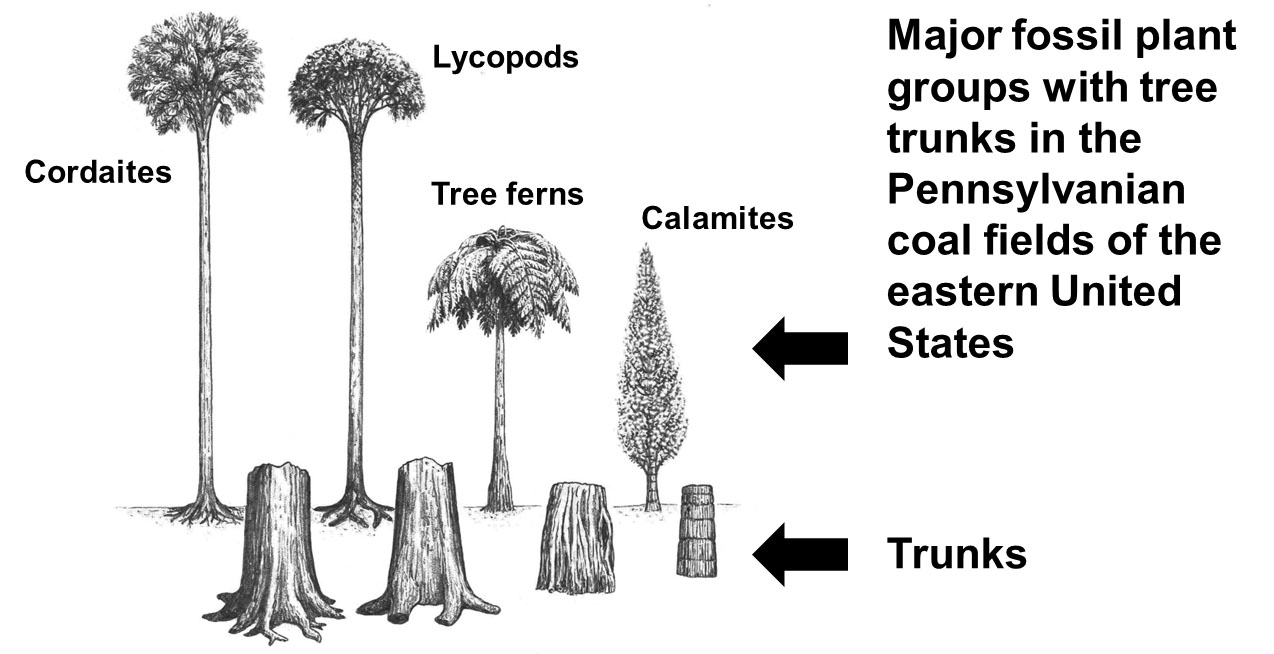
Lycopod trees: These were the most common trees in Pennsylvanian (Upper Carboniferous) wetlands and are the most common fossil tree stumps preserved in coal fields of the eastern United States and Midcontinent. Lycopods are related to modern club mosses. During the Pennsylvanian Period, these plants grew to the height of large trees. All of the trees are now extinct. Lycopods did not have woody tissues as many modern trees do. Instead, more than three-quarters of the trunk was composed of bark. Because of this difference, they likely could not withstand bacterial degradation and fires as well as modern woody trees do.
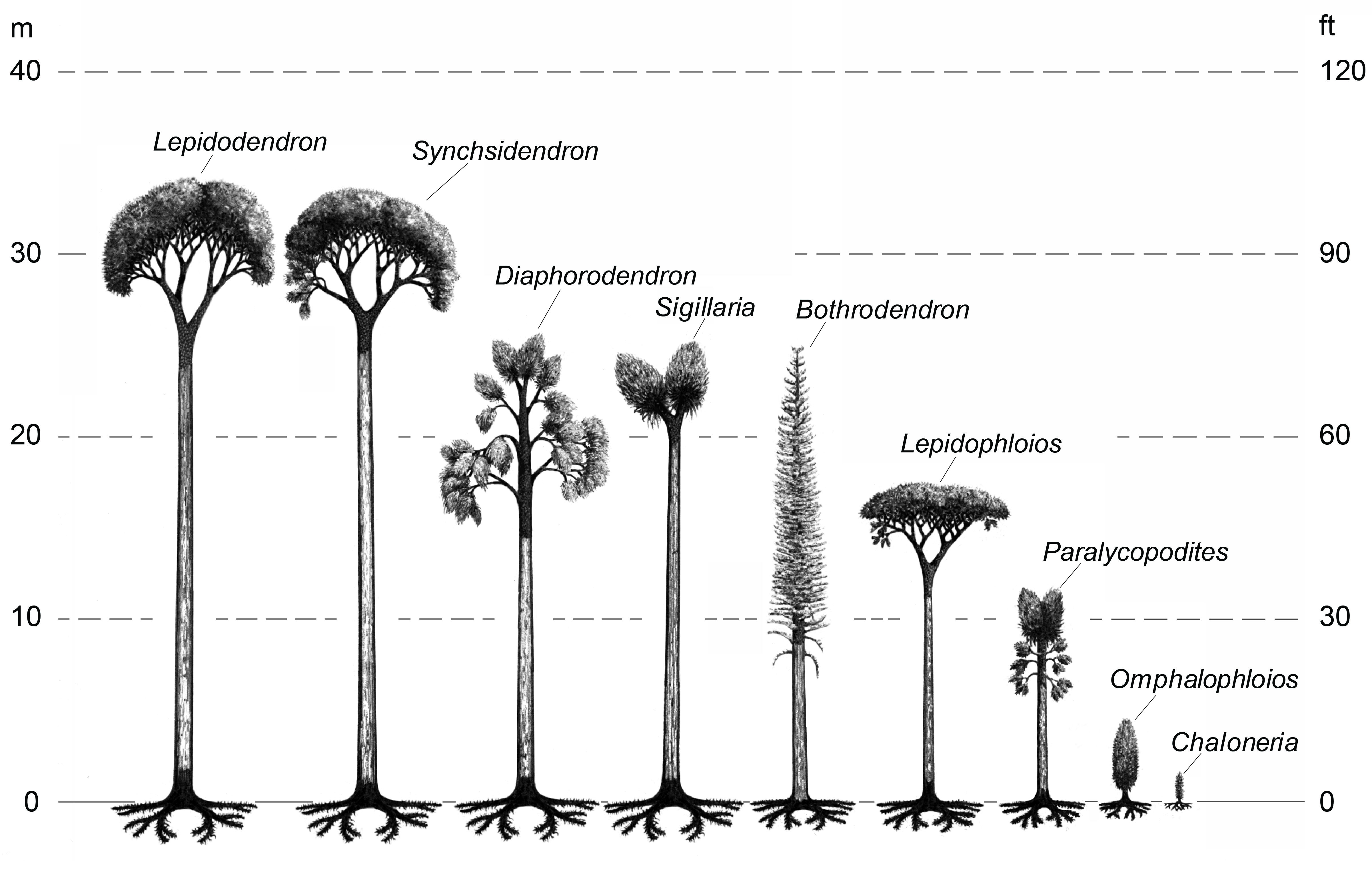
Different species of lycopods had different bark patterns. In some cases, external molds and casts of tree stumps preserve bark patterns, which can be used to distinguish specific lycopod genera (see Plant Fossils). Examples of lycopod genera that grew in Kentucky include Diaphorodendron, Lepidodendron, Lepidophlois, Paralycopodites, and Sigillaria. In most cases, however, the bases of the trees were similar, so specific genera cannot always be identified from the fossil stumps.
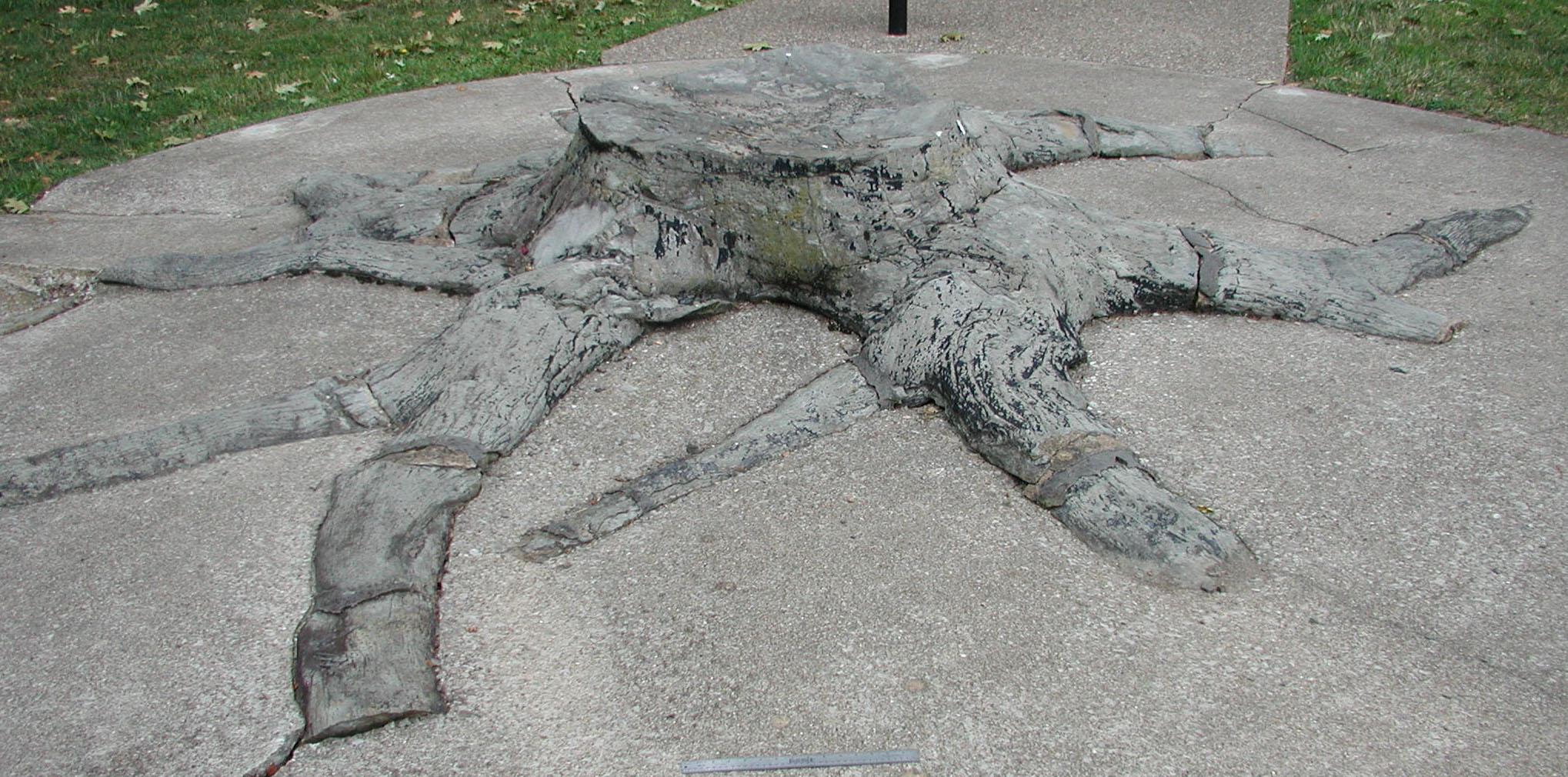
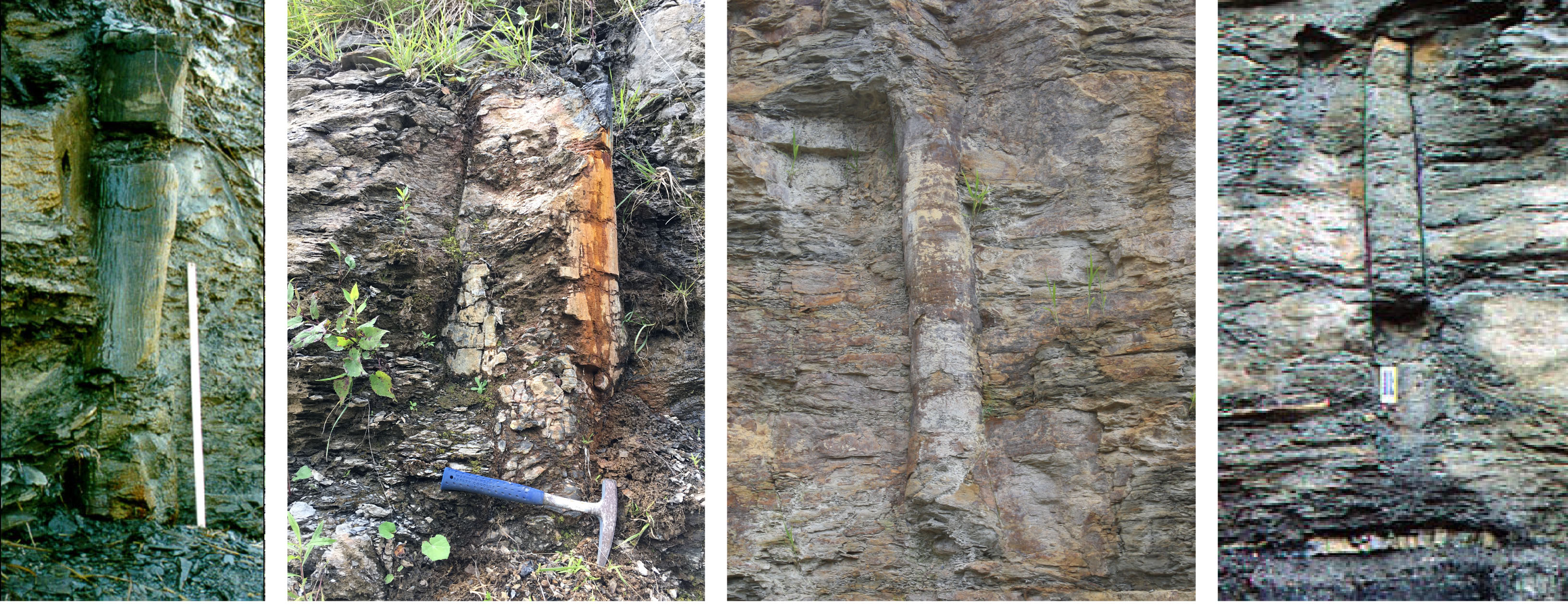
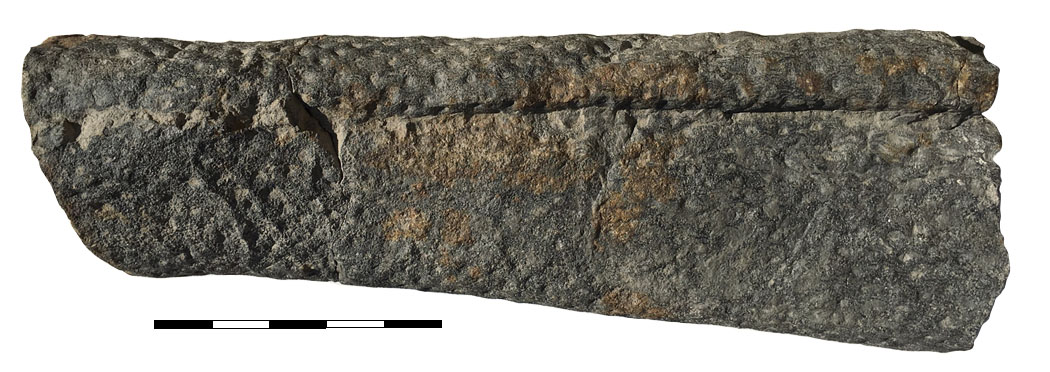
Although the Stigmaria roots of lycopod trees are common fossils, most fossil tree stumps in the coal fields are not preserved with roots. The lack of roots on many stumps is because of the way these casts and molds were formed. If the roots of the hollowed-out trees had not rotted when the stump was infilled with sediment, or if the roots had rotted, but surrounding sediment had collapsed and not left a hole to fill, no roots would be preserved.
Calamites: After lycopods, the most common fossil tree stumps preserved in the coal fields are calamites. Calamites were reed-like plants (called sphenopsids) distantly related to the modern Equisetum, or horse-tail rush. They were generally shrub-size plants (3 to 5 feet high), but some grew to the heights of small trees, similar to bamboo today. Like many wetland reeds today, they appear to have occupied river margins, lake margins, and disturbance-prone environments (for example, floodplains and levees). Preserved calamite stumps are smaller than most lycopod stumps. Most upright calamites preserved in growth position are less than 1 foot in height and 6 inches in diameter. They tend to have closely spaced parallel grooves and ridges along the long axis of the trunk, cut by transverse ridges across the width of the trunk. Although small, they are relatively common in Pennsylvanian strata of Kentucky. Transported stems and leaves from these plants are abundant fossils (see Plant Fossils).
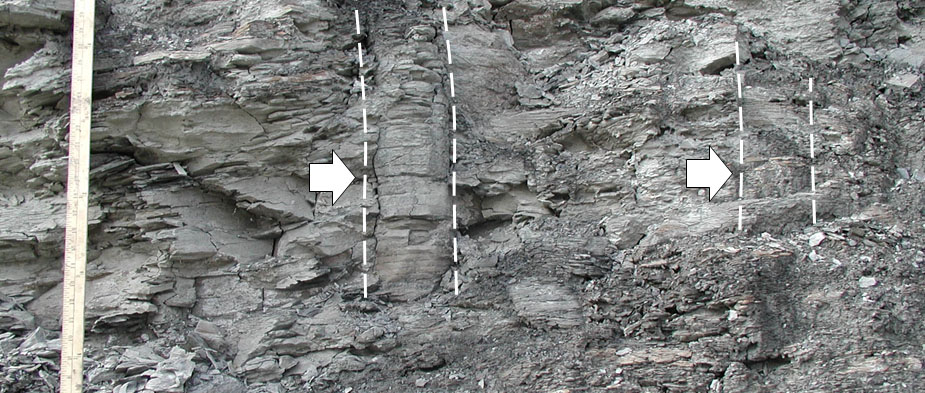
Cordaite trees: Cordaites are a type of gymnosperm (seed-bearing) tree that also lived during the Pennsylvanian Period. They are now extinct. Modern gymnosperms include conifers (for example, cypress, pine, fir, cedar) and cycads. They have woody tissue. Cordaites leaves and pith casts (called Artesia) are common above several coal seams, especially in Middle Pennsylvanian strata (see Plant Fossils). The pith casts and some logs are especially common as transported lags in sandstones, interpreted to be ancient river channels. To date, however, no definitive, in-place standing Cordaites stumps have been documented in Kentucky. It is possible that these trees preferred upland habitats, and were less common in the lowland swamp, lake, and river-margin environments commonly preserved in the rocks of the coal fields. Cordaites leaves are found in some shales and coaly strata, however, so some species may have been adapted to wetland habitats. Because they have a wood-tissue core, these trees may have been more difficult to naturally hollow out than for lycopod trees with nonwoody cores. Without hollowing prior to burial, filling these trees with sediment would be more difficult, as well as preserving a mold of a standing fossil tree.
Tree ferns: There are many different types of ferns in the world today, and there were many types of ferns in the ancient wetlands of the Pennsylvanian. Most ferns are shrubby and live close to the ground. Others have tree forms. Pennsylvanian tree ferns were different genera and species than those that live today, but their overall appearance and ecology appears to have been similar to modern tree ferns. Relative to other trees, tree ferns are "cheaply constructed" (DiMichelle and Phillips, 1994; Baker and DiMichelle, 1997): tree ferns do not have a thick woody stump, but instead, their trunks are composed of a mantle of roots (adventitious roots) that surround a central core stem to provide strength and support vertical growth. When modern tree ferns die, they decompose rapidly, and do not tend to leave stumps that can be preserved as fossils. This was likely true of ancient tree ferns as well. Fossils of tree fern leaves are common in the coal fields (see Plant Fossils), but stumps are not. Fossils of adventitious root mantles have been reported in both coal fields (for example, Chesnut and others, 1992). Tree-fern root mantles are identified by the C-shaped cross section of the roots, which is typical of tree ferns. Some root balls of likely tree ferns have also been recorded in eastern Kentucky, but whether these represent root bundles that extended above the surface in life, or were parts of the root bundles in the ancient soils, is uncertain.
See Photographs of Standing Fossil Tree Trunks
Last Modified on 2021-12-21
dohertyshoundow1980.blogspot.com
Source: https://www.uky.edu/KGS/fossils/fossil-tree-stumps-types.php
0 Response to "drawing of a scale tree fossil"
Post a Comment